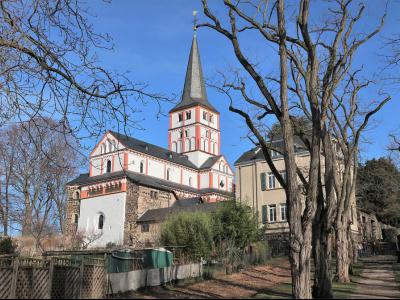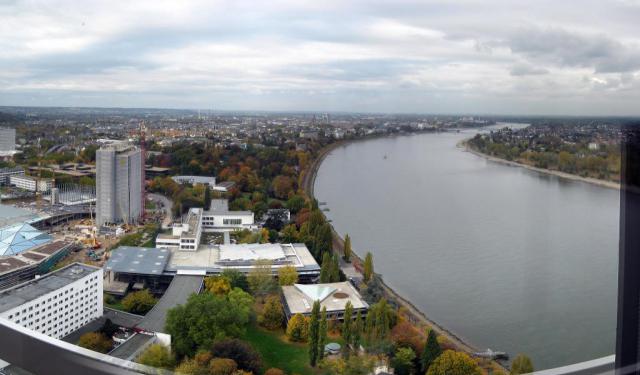
Doppelkirche Schwarzrheindorf, Bonn
The Doppelkirche Schwarzrheindorf (German: Doppelkirche St. Maria und Clemens) is a Romanesque church. The church was once part of a Benedictine nunnery located at Schwarzrheindorf, now part of Bonn. The "double church" has an upper church dedicated to the Virgin Mary and a lower church dedicated to Pope Clement I. The church is famous for its fine 12th-century frescos.
The church was probably built as a private chapel for Arnold of Wied, provost of Limburg Cathedral, Cologne Cathedral and the Basilica of Saint Servatius in Maastricht. Adjacent to the church, archaeological finds indicate that the chapel was once part of a castle belonging to the Wied family. In 1151 the Doppelkirche in Schwarzrheindorf was dedicated in the presence of King Conrad III of Germany. In the same year Arnold became archbishop of Cologne, a powerful position in that time.
After Arnold's death in 1156 his sister Hadwig of Wied turned the buildings into a monastery for Benedictine nuns. Hadwig was already abbess of Gerresheim and Essen Abbey and she now also became head of the Schwarzrheindorf congregation. Two of her sisters joined as well. Later, the monastery became a stift, a collegial body for female canons of noble origin. The upper gallery of the Doppelkirche was accessible only to the noble members of the religious community, where they were able to attend Holy Mass, separated from the commoners in the church below. In 1803 the stift was dissolved and the church was used for secular purposes until in 1868 it became a parish church.
The Doppelkirche Schwarzrheindorf is a well-preserved example of a double church from the High Middle Ages. The church has recently been plastered white but it is believed that this is what it looked like in the 12th century. It was originally conceived as a Zentralbau (central structure without a nave), following the example of the Palatine Chapel in Aachen. The church has a tall crossing tower and a dwarf gallery that not only encircles the entire apse but also both transepts. The dwarf gallery is accessible via an external staircase. The Romanesque capitals of the gallery are closely related to the carved capitals seen at the Basilica of Saint Servatius in Maastricht, where Arnold of Wied had initiated an extensive building campaign during his provostship.
The 12th-century frescos are largely original. In 1863 they were rediscovered underneath a layer of white plaster that had covered them for several decades. Both the painted upper chapel and the lower chapel are of great art historical significance. The subject matter for the frescos was derived from the teachings of contemporary theologians like Rupert of Deutz and Otto of Freising. In the upper chapel Arnold and Hadwig of Wied are painted below a Majestas Domini, stretching out on the floor as a token of humility.
The church was probably built as a private chapel for Arnold of Wied, provost of Limburg Cathedral, Cologne Cathedral and the Basilica of Saint Servatius in Maastricht. Adjacent to the church, archaeological finds indicate that the chapel was once part of a castle belonging to the Wied family. In 1151 the Doppelkirche in Schwarzrheindorf was dedicated in the presence of King Conrad III of Germany. In the same year Arnold became archbishop of Cologne, a powerful position in that time.
After Arnold's death in 1156 his sister Hadwig of Wied turned the buildings into a monastery for Benedictine nuns. Hadwig was already abbess of Gerresheim and Essen Abbey and she now also became head of the Schwarzrheindorf congregation. Two of her sisters joined as well. Later, the monastery became a stift, a collegial body for female canons of noble origin. The upper gallery of the Doppelkirche was accessible only to the noble members of the religious community, where they were able to attend Holy Mass, separated from the commoners in the church below. In 1803 the stift was dissolved and the church was used for secular purposes until in 1868 it became a parish church.
The Doppelkirche Schwarzrheindorf is a well-preserved example of a double church from the High Middle Ages. The church has recently been plastered white but it is believed that this is what it looked like in the 12th century. It was originally conceived as a Zentralbau (central structure without a nave), following the example of the Palatine Chapel in Aachen. The church has a tall crossing tower and a dwarf gallery that not only encircles the entire apse but also both transepts. The dwarf gallery is accessible via an external staircase. The Romanesque capitals of the gallery are closely related to the carved capitals seen at the Basilica of Saint Servatius in Maastricht, where Arnold of Wied had initiated an extensive building campaign during his provostship.
The 12th-century frescos are largely original. In 1863 they were rediscovered underneath a layer of white plaster that had covered them for several decades. Both the painted upper chapel and the lower chapel are of great art historical significance. The subject matter for the frescos was derived from the teachings of contemporary theologians like Rupert of Deutz and Otto of Freising. In the upper chapel Arnold and Hadwig of Wied are painted below a Majestas Domini, stretching out on the floor as a token of humility.
Sight description based on Wikipedia.
Want to visit this sight? Check out these Self-Guided Walking Tours in Bonn. Alternatively, you can download the mobile app "GPSmyCity: Walks in 1K+ Cities" from Apple App Store or Google Play Store. The app turns your mobile device to a personal tour guide and it works offline, so no data plan is needed when traveling abroad.
Doppelkirche Schwarzrheindorf on Map
Sight Name: Doppelkirche Schwarzrheindorf
Sight Location: Bonn, Germany (See walking tours in Bonn)
Sight Type: Religious
Sight Location: Bonn, Germany (See walking tours in Bonn)
Sight Type: Religious
Walking Tours in Bonn, Germany
Create Your Own Walk in Bonn
Creating your own self-guided walk in Bonn is easy and fun. Choose the city attractions that you want to see and a walk route map will be created just for you. You can even set your hotel as the start point of the walk.
Bonn Introduction Walking Tour
In 12 BC or thereabouts, the Roman army established in the Rhine valley, a large military encampment called "Castra Bonnensis." Literally "Fort Bonn." Built of wood at first and then replaced by stone, the fort lasted well into the 5th century AD.
The old fort materials were used to build Bonn's 13th century walls. The medieval city formed around the Romanesque church... view more
Tour Duration: 1 Hour(s)
Travel Distance: 2.4 Km or 1.5 Miles
The old fort materials were used to build Bonn's 13th century walls. The medieval city formed around the Romanesque church... view more
Tour Duration: 1 Hour(s)
Travel Distance: 2.4 Km or 1.5 Miles
Beethoven Trail
One of the most recognized music geniuses, whose works remain mainstays of the classical music repertoire around the world, Ludwig van Beethoven saw the light of day in Bonn in 1770. Needless to say that the legacy of the city’s most famous resident is highly respected and honored today. Indeed, Beethoven's presence is still very much felt throughout Bonn, encountering visitors in many... view more
Tour Duration: 1 Hour(s)
Travel Distance: 1.5 Km or 0.9 Miles
Tour Duration: 1 Hour(s)
Travel Distance: 1.5 Km or 0.9 Miles


